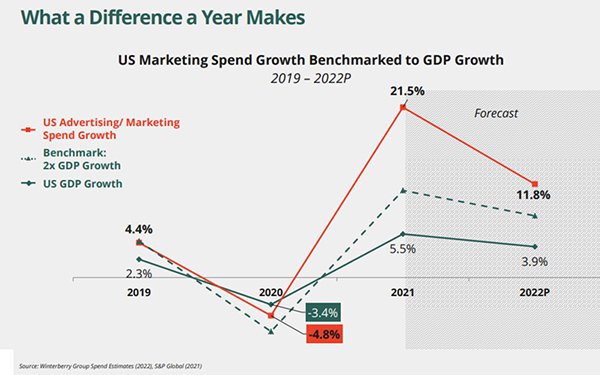U.S. Advertising, Marketing Spend Up Nearly 22% In 2021
- by Laurie Sullivan @lauriesullivan, January 20, 2022

Winterberry Group, a consultancy that supports growth initiatives in advertising, marketing, media, information, data and technology, released new research on Thursday suggesting the industry made a comeback from “COVID-recessed” 2020.
Analysts at Winterberry Group reviewed 20 media channels, with nine offline and 11 digital channels, to develop a trend pattern and outlook for 2022.
Marketers in 2021 spent $436.3 billion -- up 21.6% compared with $358.8 billion in 2020. Analysts expect continued growth of 11.8% in 2022 to $487.8 billion.
The Outlook for Advertising, Marketing and Data 2022 research report shows that the advertising and marketing sector had its strongest year in the last decade.
Winterberry Group Senior Managing Partner Bruce Biegel presented the data at the Direct Marketing Club of New York virtual event. Biegel led the annual research. Findings provide forecasts and insights on trends driving U.S. advertising and marketing spend in 2022.
Retail Media marketing rose to $40 billion in 2021, up from $20 billion the year prior.
Experiential and sponsorship bounced by $10 billion off the historic lows of 2020, while connected television (CTV) rose $6 billion, with expectations it will rise another $5 billion in 2022.
Spend related to data such as identity, analytics, platforms and measurement and attribution rose 26% to $29.3 billion compared with the prior year. It is forecast to gain another 13% in 2022.
Marketers should expect headwinds from the loss of online and mobile identifiers shifted spend toward the collection and use in personalization of first-party data across all online and offline platforms; adoption of data management and cleanroom solutions; use of alternative identity solutions, including contextual targeting; and a rebound in direct mail acquisition fueling third-party data spend.
In aggregate, spend on data as a percent of total media increased from 11.6% in 2021 to 12.3% in 2022. It’s not clear whether, if passed, the “Banning Surveillance Advertising Act,” introduced Tuesday by Democrat Reps. Anna Eshoo, Jan Schakowsky, and Senator Cory Booker, will impact predictions in 2022.
Key growth drivers expected to impact 2022 include:
- A loss of identifiers in media, driven by privacy concerns, will force marketers to support a range of identity solutions with “test” moving to roll-out by year end.
- Efforts to attract, retain and compensate industry talent will continue for at least another 12 months.
- The shift from campaign-centric marketing to customer-centric and journey-based approaches.
- Increased investments and market consolidation, fueled by $100’s of billion in venture capital, private equity and public market capital.


